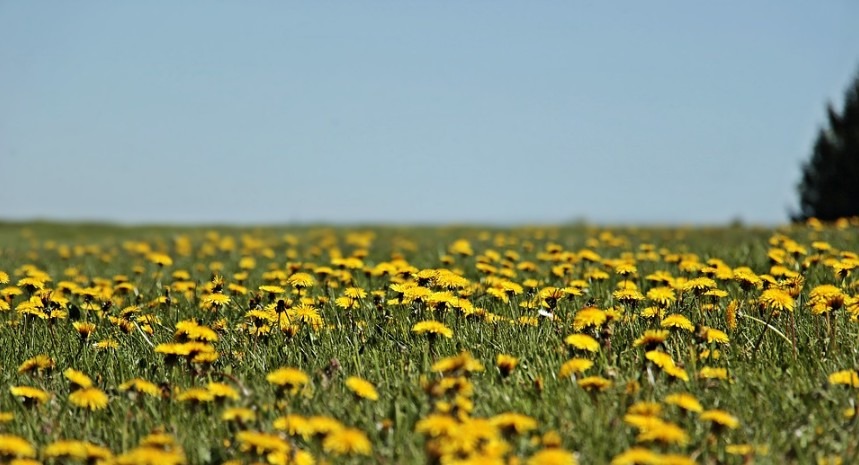Dandelions are well known and easily recognized. The common one is either Taraxacum officinale or T. erythrospermum. Many people consider them weeds to be killed and eliminated from the yard. However, dandelions are not only bright and cheerful, they draw pollinators, and they are also immensely edible, and useful for health purposes, as well.
Health Benefits and Side Effects
Two of dandelion’s compounds, chicoric and chlorogenic, may reduce blood sugar levels. Tests are still being done to see if this can be useful for managing blood sugar levels in people with type 2 diabetes.
Dandelion can be helpful for lowering cholesterol. There is also evidence that it can lower blood pressure.
Substances in dandelion support the liver and cause it to function more efficiently and effectively. Its antioxidants help to remove toxins before they even reach the liver.
Dandelion also contains compounds that can assist in weight loss, by boosting the metabolism and pushing fats out of the body rather than being absorbed.
Because it is high in B vitamins, it can improve mood, stabilize hormones, and offer extra energy.
The polyphenols in dandelion can aid in reducing inflammation. This means dandelion intake can aid in pain relief for arthritis and similar maladies.
The mix of nutrients are all known to be good for the bones, to increase their strength and prevent brittleness.
There are tests being done to see how dandelion may be usable to treat cancer. Scientists in Canada have found that it may be able to kill bad cells while leaving the good cells unharmed.
Dandelion also acts as a strong diuretic.
The milky sap that fills the stems of dandelions can be used topically to treat skin issues like eczema. Check it on a small area of skin first to check for a reaction; some people may have an allergic reaction, though this is not common. It happens most often in people who are allergic to ragweed and similar plants or anything in the Asteraceae plant family. It also contains iodine and latex, so allergies to these substances may also be a reason to avoid dandelion.
Dandelion’s effect on things that are usually processed by the liver can cause issues with some prescription drugs, such as antibiotics, antidepressants, antipsychotics, diuretics, statin drugs, and contraceptives that are based on estrogen.
The fiber in dandelion is inulin, to which some people are sensitive.
Food and Nutrition
As a food source, dandelions are rich in nutrients including vitamins A, B, C, D, and K, potassium, magnesium, calcium, and iron. The root contains carbohydrates and fiber as well and feeds the healthy bacteria in the intestines. The plant also contains antioxidants.
Its taste is somewhat bitter, similar to chicory. It has been said that the leaves, if picked before the plant flowers, are less bitter.
Dandelion tea can make an excellent morning drink for those who choose to avoid coffee or who dislike it. It will offer its health benefits and is caffeine-free but will still boost energy levels due to its B vitamins.
Dandelion leaves are a great addition to a fresh salad. 100g of fresh dandelion leaves provide 45 calories, 2.7g of protein, .7g of fat, 9.2g carbohydrates, 3.5g fiber, and the nutrients listed above, plus a variety of other trace minerals.
Some people enjoy dandelion wine, which can be made at home or purchased from certain wineries.
The flowers can be fried or added to other dishes.
Dandelion leaves can be used in pesto or similar spreads to add color and flavor.
The greens can also be sautéed or fried, added to soup, or made into jelly.
Other Uses
The bright yellow flowers, when dried and ground into powder, can be used to dye cloth items.
The latex content has been cultivated to use as a form of rubber. This is being researched for use in tires or other traditionally rubber items.
Growing
Dandelions sow their own seeds; the white puffy balls that children blow into the air to make wishes or watch them fly are the seeds, which are likely to take root wherever they land. However, it is also possible to get dandelion seeds to cultivate your own garden of dandelions.
They have broad, notched leaves and several stems, growing up from a taproot. The stems can reach a height of nearly a foot tall. Dandelions like whatever soil they can find to grow in. All parts can be eaten; the root is best harvested after at least two years of growth in order to be large enough.
While the leaves are best picked before the plant flowers, the flowers are also edible and can be picked at any time. Roots should be harvested in the fall. Keep in mind that the roots will absorb any toxins present, so those that are grown near toxic substances, such as septic tanks, asphalt, etc., should be avoided. Roots can be dried and kept in a sealed jar for as long as a year.

